Raytheon (Texas Instruments) Paveway III
(GBU-21/B, GBU-22/B, GBU-23/B, GBU-24/B, GBU-27/B,
GBU-28/B, GBU-33/B)
History and General Description
By the late 1970s, Paveway II laser-guided bombs were standard precision-attack air-to-ground weapons in the U.S. inventory. However, they were not well suited to release at low level for several reasons. To achieve a worthwhile stand-off range from a low-level launch, the LGB had to be released in a pull-up manoeuver to send the bomb on a lofted trajectory. But when the Paveway II's seeker detected the laser reflection too soon after release, the simple control logic would immediately pop down the bomb, which would then have insufficient range to reach the target. Because low-level attacks were mandatory in the presence of capable air-defense systems, Texas Instruments received a development contract in 1980 for a low-level LGB (LLLGB) guidance package, labeled Paveway III.
The Paveway III GCU (Guidance and Control Unit) has a microprocessor-based autopilot, which implements proportional control in place of the cruder "bang-bang" (either full deflection of control surfaces or none at all) autopilot of earlier Paveways. This provides for a much smoother and therefore more efficient flight path. Furthermore, the scanning laser seeker has a larger field of view, and the tailfins have been enlarged for higher manoeuverability and aerodynamic efficiency. The improvements enable a Paveway III LGB to maintain level flight at low altitude for effective ranges of more than 18 km (10 nm). Other delivery options include high-altitude drops (with a range of about 30 km (16 nm) from 10000 m (33000 ft) altitude) or long-range low-altitude launches using a lofted trajectory.
Originally, Paveway III guidance kits were to be built for four different warheads: a new HSM (Hard Structure Munition), which didn't materialize, and the 500 lb MK 82, 1000 lb MK 83 and 2000 lb MK 84 standard bombs. Of these only the MK 84 version was procured for operational service as the GBU-24/B, but later other warheads were also adopted for Paveway III guidance (see Variants section below for a detailed rundown of all versions). Paveway III entered service with the U.S. military in 1983, and has since been operationally used in all U.S. air offensives. More than 10000 kits have been procured by the U.S. military so far. Because Paveway III guidance kits are significantly more expensive than Paveway II kits, the latter are nevertheless still in service and won't be retired in the near future. Current prime contractor for all Paveway III guidance systems is Raytheon.
 |
| Photo: via GlobalSecurity.org |
| GBU-24/B, GBU-24A/B, GBU-24B/B |
In optimum conditions, a Paveway III LGB can have an accuracy of 1 m (3.6 ft) CEP. However, laser guidance doesn't work very well in bad weather, and when the illuminating laser is switched off for any reason, guidance is completely lost. To overcome these shortcomings, the development of a GPS-aided inertial add-on package for Paveway III GCUs began in the late 1990s. Flight tests began in 1999, and GPS/INS-enabled Paveway III LGBs became available for operational service in 2000. GPS/INS-enabled LGBs are frequently referred to as EGBUs (E = Enhanced). The general homing method of EGBUs is to use the GPS/INS unit for mid-course guidance (giving the control logic a whole new set of options for optimum flight paths, and greatly expanding the delivery envelope) and the laser seeker for terminal homing. Should laser designation and/or GPS reception fail, the accuracy is degraded but not completely lost.
Variants
GBU-21/B
The GBU-21/B was to be a 2000 lb class HSM (Hard Structure Munition) warhead with a Paveway III guidance kit, but this version was not built.
GBU-22/B
The GBU-22/B is a 500 lb MK 82 bomb with a Paveway III guidance kit. It uses a BSU-82/B airfoil group, and can be fitted with all standard Paveway III GCUs (WGU-12( )/B, WGU-39( )/B and WGU-43( )/B series). The GBU-22/B was not produced for the U.S. military, but it is included by Raytheon in the list of available Paveway III variants.
 |
| Photo: USAF |
| GBU-22/B (background: GBU-24/B) |
GBU-23/B
The GBU-23/B was to be a 1000 lb MK 83 bomb with a Paveway III guidance kit. This version was not built.
GBU-24/B
The GBU-24/B series covers Paveway III LGBs with warheads in the 2000 lb class. These bombs are by far the most important and numerous Paveway III weapon. The following warheads are used in GBU-24/B series LGBs:
- MK 84: Standard 2000 lb LDGP (Low-Drag General Purpose) bomb
- BLU-109/B: 2000 lb class penetrator warhead
- BLU-116/B: 2000 lb class AUP (Advanced Unitary Penetrator) warhead
It can be assumed that other 2000 lb warheads, which use MK 84 or BLU-109 casings, can also be fitted with GBU-24 series Paveway III guidance kits. This includes e.g. the BLU-118/B and BLU-121/B thermobaric bombs.
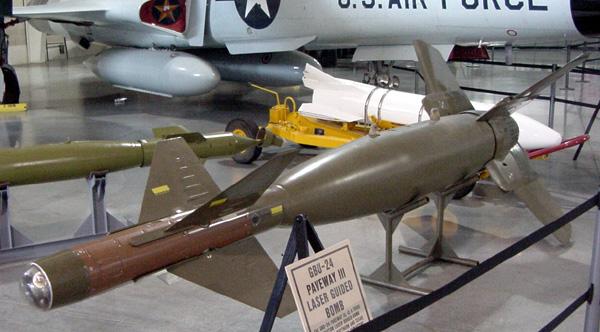 |
| Photo: Hill Aerospace Museum |
| GBU-24/B |
The original GCU of the 2000 lb Paveway III LGBs was the WGU-12/B, later followed by the WGU-39/B. The WGU-39A/B GCU adds a GPS/INS unit, and GBU-24s so equipped are informally known as EGBU-24.
Apart from the GBU-24/B series of the U.S. military, which uses suffix letters to distinguish between variants, there is also a GBU-24(V)/B series. These designations are applied to 2000 lb Paveway IIIs for export, which all use GCUs in the WGU-43( )/B series. The WGU-43/B is the original GCU of the UK's GBU-24/B bombs, and was possibly also known as WGU-39(UK). The WGU-43A/B is another UK version with different laser PRF (Pulse Repetition Frequency) codes, while the WGU-43B/B is for export to non-NATO countries, and includes only commercial PRF codes. The WGU-43G/B is the GPS/INS-enhanced GCU in this series. It is a derivative of the WGU-39A/B for export to NATO countries, and contains all NATO-cleared PRF codes. The WGU-43H/B is a modification of the WGU-43G/B, and contains limited PRF codes for non-NATO countries.
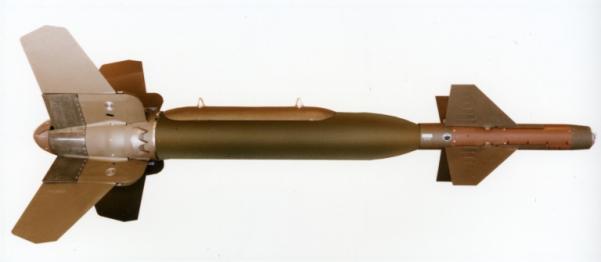 |
| Photo: USAF |
| GBU-24A/B |
Known designations of GBU-24/B variants include:
| Designation | Warhead | GCU | Airfoil Group | Fuze | User |
|---|---|---|---|---|---|
| GBU-24/B | MK 84 | WGU-12/B or -12A/B | BSU-84/B | FMU-81( )/B or FMU-139( )/B | USAF, USN |
| GBU-24A/B | BLU-109/B | WGU-12B/B | FMU-143( )/B | USAF | |
| GBU-24B/B | BLU-109A/B | WGU-39/B | USN | ||
| GBU-24C/B | BLU-116/B | WGU-12B/B or WGU-39/B | BSU-84/B or -84A/B | FMU-157/B | USAF |
| GBU-24D/B | WGU-39/B | USN | |||
| GBU-24E/B 1 | BLU-109A/B | WGU-39A/B | BSU-84B/B | FMU-143E/B | USAF, USN |
| GBU-24F/B | BLU-116A/B | WGU-39/B | BSU-84/B or -84A/B | FMU-159/B | USN |
| GBU-24G/B 1 | WGU-39A/B | BSU-84B/B | |||
| GBU-24(V)1/B | MK 84 | WGU-43/B | BSU-84A/B | FMU-81( )/B | |
| GBU-24(V)2/B | BLU-109( )/B | FMU-143( )/B | |||
| GBU-24(V)3/B | MK 84 | WGU-43B/B | FMU-81( )/B | ||
| GBU-24(V)4/B | BLU-109( )/B | FMU-143( )/B | |||
| GBU-24(V)5/B | (No information about this nomenclature is available. It was possibly never assigned.) | ||||
| GBU-24(V)6/B | |||||
| GBU-24(V)7/B | MK 84 | WGU-43A/B | BSU-84A/B | FMU-81( )/B | |
| GBU-24(V)8/B | BLU-109( )/B | FMU-143( )/B | |||
| GBU-24(V)9/B 1 | MK 84 | WGU-43G/B | FMU-81( )/B | ||
| GBU-24(V)10/B 1 | BLU-109( )/B | FMU-143( )/B | |||
| GBU-24(V)11/B 2 | (No information about this nomenclature is available.) | ||||
| GBU-24(V)12/B 1 | BLU-109( )/B | WGU-43H/B | BSU-84A/B | FMU-143( )/B | |
Notes:
- These variants are GPS/INS-enhanced EGBU-24 versions.
- The GBU-24(V)11/B nomenclature may have been reserved for a variant with a MK 84 warhead and a WGU-43H/B guidance kit.
GBU-27/B
The large fins of the GBU-24/B series weapons don't fit into the bomb bay of the F-117A Nighthawk, and therefore the USAF developed the GBU-27/B, a specially configured 2000 lb class Paveway III for use by the F-117. The primary difference from the GBU-24/B is that the GBU-27/B uses a Paveway II-type airfoil group, and slightly more compact suspension logs. All GBU-27/B series weapons use penetrating warheads, either the BLU-109/B or the BLU-116/B. When fitted with GPS/INS-enabled WGU-39A/B GCUs, the GBU-27/B LGBs are informally referred to as EGBU-27. The GBU-27/B entered service in 1987, and about 3200 rounds have been produced.
 |
| Photo: USAF |
| GBU-27/B |
Known designations of GBU-27/B variants include:
| Designation | Warhead | GCU | Airfoil Group | Fuze |
|---|---|---|---|---|
| GBU-27/B | BLU-109/B | WGU-25( )/B | BSU-88/B | FMU-143( )/B |
| GBU-27A/B 1 | BLU-109/B | WGU-39A/B | BSU-88A/B | |
| GBU-27B/B 1 | BLU-116/B | BSU-88( )/B 2 | FMU-157/B |
Notes:
- These variants are GPS/INS-enhanced EGBU-27 versions.
- The exact designation of the GBU-27B/B's airfoil group is unavailable (most likely either BSU-88A/B or -88B/B).
GBU-28/B
During Operation Desert Storm in early 1991, the U.S. Air Force had to find out that the deepest and most hardened Iraqi bunkers could not be defeated by the BLU-109/B penetrator warhead. Therefore a much more powerful "bunker buster" warhead was urgently needed. Several options were discussed, but even the quickest possible alternative (an upscaled BLU-109) was estimated to have a development time of at least 4-5 weeks. Finally, USAF engineers at Eglin AFB came up with the idea to drop a very heavy guided bomb from high altitude, creating a powerful kinetic energy penetrator. The USAF eventually opted for the development of a 4500 lb bomb with Paveway III laser guidance.
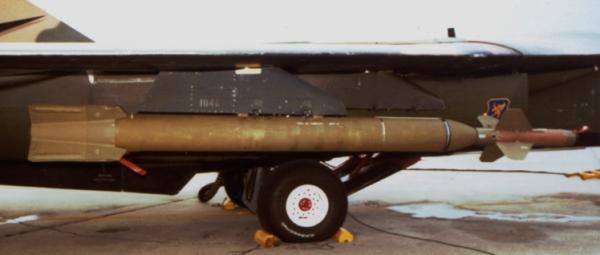 |
| Photo: Texas Instruments |
| GBU-28/B |
To save time, practically all parts of the new bomb, designated GBU-28/B, were modified off-the-shelf components. The body of the BLU-113/B warhead was made of surplus U.S. Army M201 howitzer gun barrels, the nose cone and the explosive was from the BLU-109/B, and the WGU-36/B guidance package was a GBU-24/B Paveway III GCU with software modifications to handle the different aerodynamics of the new LGB. The final decision to go ahead with development and deployment of the weapon came on 13 February 1991, followed only 11 days later by the successful drop test of the first prototype. Another three days later, GBU-28/B prototypes number three and four were dropped on an Iraqi bunker.
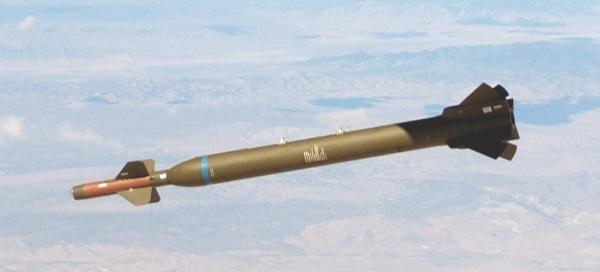 |
| Photo: Tech. Sgt. Michael Ammons, USAF |
| GBU-28A/B |
Only the initial batch of BLU-113/B warheads was made from howitzer gun barrels, and later purpose-build warheads were designated BLU-113A/B. The latest warhead used in the GBU-28/B series is the BLU-122/B, which was developed under the BLU-113 P3I (Pre-Planned Product Improvement) program. It has unspecified improvements in warhead design and explosives, to enhance penetration capability and general effectiveness. Like other Paveway III GCUs, the GBU-28/B's WGU-36/B has also been enhanced with a GPS/INS package. This is included in WGU-36B/B and later versions, and GBU-28s so equipped are informally referred to as EGBU-28. The primary delivery aircraft for the GBU-28/B series LGBs is the F-15E Eagle.
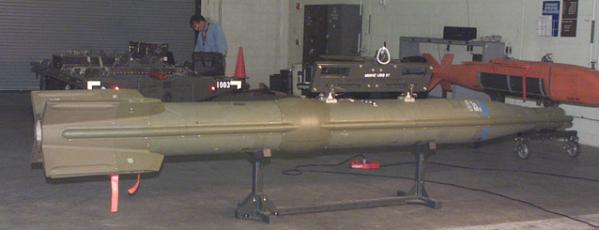 |
| Photo: USAF |
| GBU-28C/B (w/o seeker and canards) |
Known designations of GBU-28/B variants include:
| Designation | Warhead | GCU | Airfoil Group 1 | Fuze |
|---|---|---|---|---|
| GBU-28/B | BLU-113/B | WGU-36/B | BSG-92/B | ? |
| GBU-28A/B | BLU-113A/B | WGU-36A/B | ||
| GBU-28B/B 2 | BLU-113( )/B | WGU-36B/B 3 | BSG-92A/B | FMU-143F/B, G/B or H/B |
| GBU-28C/B 2 | BLU-122/B | WGU-36D/B 3 | BSG-92B/B | FMU-143F/B, G/B, H/B or FMU-152/B |
| GBU-28D/B 2 | BLU-122/B | WGU-36E/B | BSG-92B/B | FMU-143G/B, H/B or FMU-152A/B |
| GBU-28E/B 2 | BLU-113( )/B | WGU-36E/B | BSG-92A/B | FMU-143F/B, G/B or H/B |
Notes:
- Many sources quote the designation of the GBU-28/B series' airfoil group as BSU-92( )/B, but official files show the BSG nomenclature.
- These variants are GPS/INS-enhanced EGBU-28 versions.
- These designations are from the official USAF source ([4]). Raytheon ([2]) lists WGU-39C/B and -39D/B for the GBU-28B/B and -28C/B, respectively.
GBU-33/B
The designation GBU-33/B was reserved for export versions of the GBU-24/B series 2000 lb Paveway III bombs. However, these export versions are now officially designated in the GBU-24(V)/B series (see GBU-24/B section above), and it appears that the GBU-33/B nomenclature has been cancelled.
Specifications
Note: Data given by several sources show slight variations. Figures given below may therefore be inaccurate!
Data for GBU-24/B, GBU-24A/B, GBU-27/B, GBU-28A/B:
| GBU-24/B | GBU-24A/B | GBU-27/B | GBU-28A/B | |
|---|---|---|---|---|
| Length | 4.39 m (14 ft 5 in) | 4.32 m (14 ft 2 in) | 4.24 m (13 ft 11 in) | 5.84 m (19 ft 2 in) |
| Diameter | 46 cm (18 in) | 37 cm (14.5 in) | 35.6 cm (14 in) | |
| Fin span (extended) | 2.00 m (6 ft 6.75 in) | 2.03 m (6 ft 8 in) | 1.68 m (5 ft 6 in) | |
| Weight | 1050 kg (2315 lb) | 1065 kg (2348 lb) | 984 kg (2170 lb) | 2076 kg (4576 lb) |
| Warhead | MK 84 bomb | BLU-109/B | BLU-113/B | |
Main Sources
[1] GlobalSecurity.org Website
[2] Raytheon Website
[3] Carlo Kopp: "The GBU-28 Bunker Buster", 1998 & 2005
[4] USAF nomenclature records for GBU series designations
[5] Jeremy Flack: "NATO Air Launched Weapons", The Crowood Press, 2002
Back to Directory of U.S. Military Rockets and Missiles, Appendix 5
Last Updated: 21 August 2008